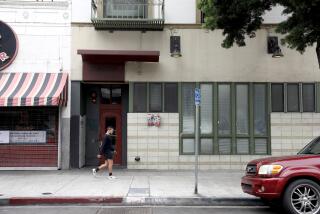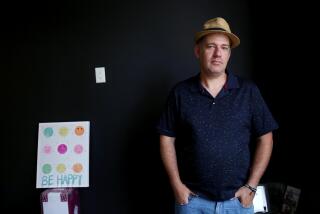Skid Row: Not New, and It Won’t Go Away : Homelessness: It’s not just an alcohol or mental-illness problem; some street people can’t return to the world.
Skid Row has always been an inner-city version of a desert island, the home of the ultimate dropout from a world whose demands have become emotionally overpowering. For some of its inhabitants, the ability to cope was lost along the way, and some never were able to live in the structure called society.
Society is confronted here with men and women whose surface problems appear to be homelessness or alcohol or drugs or mental disarray, but whose basic emotional discord goes much deeper.
Despite the current political rhetoric, it’s not a new condition, nor is it a result of different government administrations or economic swings. Skid Rows are present in one form or another in every major urban area in the world, and have existed for many generations. For example, the three largest Skid Row facilities in Los Angeles were started well before World War I.
Endless studies, dozens of major social experiments, hundreds of agencies and the expenditure of many millions of dollars have had no significant effect in ending this most perplexing example of homelessness. In fact, the situation is arguably worse today than ever before.
To compound the problem, most of the men and women living in these dreadful conditions seem to be extremely reluctant to participate in any form of rehabilitation or recovery that requires a major effort on their own part. In a sense, this is the paradox of Skid Row: People who have lost the emotional ability to help themselves can only be helped if they try to help themselves.
The net result has been intermittent periods of frustrated aid and benign neglect from government, with the day-to-day care efforts coming primarily from local missions and social agencies.
Surprisingly enough, there have been some positive results in cases where a controlled situation can be enforced. At the Midnight Mission, for example, every employee on our staff has come to us from Skid Row at one time or another, and many are today working at levels that would have once been impossible for them. A strict work-ethic atmosphere enables these people to regain the self-worth to live in a stressful world.
It’s a long procedure for some and many fall back into their old lives, but we know that it is successful. Not only because of the 70 clean, clear-eyed people on our payroll, but also because of a significant group of “alumni” who have made the transition to living in the outside world.
As an indication of the success of this work ethic, the state for several years has operated a regular employment office in the Midnight Mission, the only installation of its type in the entire state system.
On the other hand, we serve almost 1,700 meals a day, and most go to people who will live and die on Skid Row without ever being able to break the psychological barrier that exists at the edge of this dreary area.
Obviously there are no simple answers, or they would have been found long ago by dedicated people, but there are a few things that are essential if we’re going to begin any meaningful change in this community of human desperation.
These include halfway houses with adequate counseling and guidance facilities for Skid Row’s mentally ill, and more effective drug enforcement by local and federal agencies, since crack cocaine is almost easier to obtain here than cigarettes. We also need live-in drug rehabilitation facilities for addicts, without the current 6- to 18-month waiting period, by which time the addict is in prison or dead. We need more facilities for women and anything that will also help street children, who are currently all but unserved. There is a dearth of help for the Spanish-speaking homeless immigrants now flooding our back streets and alleys.
These are some of the more obvious needs. There are others that are less visible. We must reevaluate the Welfare and General Relief system on Skid Row. An amazing number of young and healthy people support their drug habits with welfare while they live on the streets and prey on others, and we must provide an escape hatch for the long-term alcoholics who live and die on these streets, perhaps in the form of a facility such as the county’s old farm at Saugus, where “hopeless” street drunks could be sent for up to 180 days of fresh air, sunshine, good food, simple jobs, cleanliness and the assistance of Alcoholics Anonymous. When this program closed some years ago, the best chance to legally move a street drunk out of Skid Row for a chance for physical and mental recovery disappeared.
Such programs would be only a beginning. But that’s where all journeys start.
More to Read
Sign up for Essential California
The most important California stories and recommendations in your inbox every morning.
You may occasionally receive promotional content from the Los Angeles Times.






